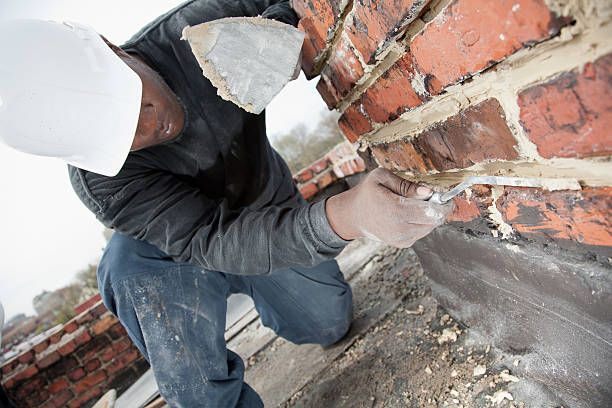Opening the Secrets of Lasting Masonry Building Practices for Eco-Friendly Buildings
In the world of contemporary construction, the pursuit of lasting methods has come to be vital. Among the myriad approaches to environmentally friendly building, sustainable stonework construction stands out as a tried and true and sturdy technique that holds a wealth of untapped potential. From the selection of materials to innovative building techniques, the keys to achieving sustainability within masonry building are complex and appealing. By exploring the benefits, products, techniques, and future patterns of lasting masonry, a deeper understanding of exactly how these practices can form the future of green structures arises.
Benefits of Sustainable Masonry Construction
Accepting sustainable stonework building and construction methods not just minimizes environmental impact but also supplies long-lasting economic advantages to home builders and neighborhoods. By utilizing materials like recycled bricks, blocks, and rocks, home builders can dramatically reduce the carbon footprint of their projects while promoting source performance. Additionally, lasting masonry building strategies, such as appropriate insulation and thermal mass buildings, can improve energy effectiveness within buildings, bring about reduced operational costs with time.
Furthermore, the toughness and resilience of masonry frameworks add to lasting financial benefits. Buildings built using sustainable masonry practices usually require much less upkeep and repair service, translating to cost savings for home builders and homeowner. The durability of stonework materials additionally ensures that structures remain secure and protected, lowering the demand for constant remodellings or replacements.
Eco-Friendly Stonework Products
Making use of environment-friendly stonework materials is a pivotal action in the direction of boosting the sustainability of construction practices and minimizing environmental effect while maximizing long-term financial advantages. Sustainable masonry products are sourced, produced, and utilized in a fashion that decreases total ecological effect. Materials such as recycled blocks, reclaimed rock, and lasting concrete blocks are coming to be progressively prominent options for eco-conscious contractors. Recycled blocks, for instance, not just divert waste from landfills however likewise require less energy to generate compared to new bricks. Reclaimed rock offers a distinct aesthetic appeal while lowering the requirement for new quarrying. Sustainable concrete blocks include recycled accumulations and may feature better insulation homes, contributing to energy performance in structures.
Furthermore, natural products like adobe, rammed earth, and straw bundles supply superb thermal mass properties, lowering the need for heating and cooling power. These materials are usually in your area available, advertising local economic climates and minimizing transportation-related carbon exhausts. By choosing environmentally friendly stonework materials, construction tasks can considerably lower their environmental footprint and add to the creation of healthier, more lasting developed environments.
Energy-Efficient Masonry Techniques
Energy effectiveness plays an essential function in improving the sustainability of masonry building methods. One crucial energy-efficient masonry strategy is the usage of thermal mass, which includes integrating dense products like concrete or brick into find out the structure's framework to soak up and store heat.

Developments in Sustainable Masonry
Current advancements in lasting stonework practices have actually caused ingenious strategies that are improving the construction market. One such advancement is the growth of self-healing concrete, which uses microorganisms embedded within the concrete to recover splits autonomously. This breakthrough not only minimizes upkeep prices yet also improves the resilience of masonry structures, adding to their sustainability.
An additional noteworthy development is the usage of recycled accumulations in stonework construction - masonry contractor. By including materials such as crushed ceramic waste or recycled glass into concrete blends, building contractors can reduce the environmental effect of building projects while preserving structural stability. This technique not just draws away waste from landfills but also saves natural deposits, making it an essential improvement in lasting stonework building
Furthermore, the integration of digital design tools, such as Structure Info Modeling (BIM), is changing the means stonework frameworks are planned and constructed. BIM permits more precise estimations, lowered product waste, and enhanced energy efficiency, eventually causing more sustainable building methods. These advancements collectively represent a promising future for sustainable masonry construction in the period of green structures.
Future Trends in Stonework Sustainability
With the cutting-edge strides made in lasting stonework practices, the future fads in visit their website stonework sustainability are positioned to further revolutionize the construction industry. One of the key patterns shaping the future of stonework sustainability is the increased integration of technology. Advancements such as decorative cement wall Structure Details Modeling (BIM) and virtual fact simulations are being utilized to maximize stonework construction processes, causing minimized material waste and improved power effectiveness in buildings.
Additionally, the growth of unique sustainable products is set to play a substantial function in enhancing the eco-friendliness of masonry building and construction. masonry contractor. Advancements like self-healing concrete, recycled aggregates, and bio-based binders are acquiring traction for their capability to minimize environmental effect while maintaining architectural stability

Final Thought
To conclude, sustainable stonework construction practices provide numerous advantages for eco-friendly structures. By making use of environment-friendly materials and energy-efficient techniques, stonework can add to a more sustainable built setting. Developments in sustainable masonry are continuously being created to better boost the ecological efficiency of structures. Looking towards the future, the trend of masonry sustainability is expected to expand, leading to even more ecologically pleasant and energy-efficient building practices in the years to come.
Comments on “Trustworthy Tuckpointing Services for Restoring Brick and Stone Surfaces”